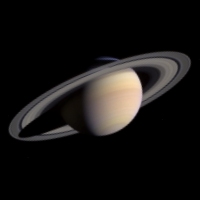Saturn
 |
Origin of name Saturn is named after the Roman god of agriculture, the father of Jupiter in Roman mythology.
Satellites
ESA Missions |
Cassini-Huygens
Cassini-Huygens is a NASA/ESA/ASI mission to explore the Saturnian system. The ESA component consists largely of the Huygens probe, which entered the atmosphere of Saturn's largest moon, Titan, and descended under parachute down to the surface.
Physical Properties
| Property | Unit | Value | Earth = 1 |
| Equatorial radius, 1 bar level | km | 60 268 | 9.449 |
| Polar radius, 1 bar level | km | 54 364 | 8.552 |
| Flattening | 0.09796 | 29.24 | |
| Mass (x1024) | kg | 568.46 | 95.159 |
| Volume (x1010) | km3 | 82 713 | 763.59 |
| Mean density | kgm-3 | 687 | 0.125 |
| Gravity at equator, 1 bar level | ms-2 | 10.44 | 1.065 |
| Escape velocity | kms-1 | 35.5 | 3.172 |
| Magnetic field at equator (x10-4) | T | 0.22 | 0.72 |
| Magnetic dipole moment (x1018) | Tm3 | ~ 4.8 | ~ 600 |
| Tilt of dipole axis | ° | < 1.0 | |
| Dipole field centre offset from planet centre (equatorial radii) | 0.04 | ||
|
Number of natural satellites (known satellites, as of March 2009) |
61 |
Orbital Parameters
| Property | Unit | Value |
| Perihelion (x106) | km | 1352.55 |
| Aphelion (x106) | km | 1514.50 |
| Mean distance from the Sun (x106) | km | 1433.53 |
| Mean distance from the Sun | AU | 9.539 |
| Eccentricity | 0.0565 | |
| Sidereal orbit period | y | 29.457 |
|
Sidereal rotation period Saturnian System III coordinates |
h | 10.656 |
| Length of day | h | 10.656 |
| Orbit inclination to Ecliptic | ° | 2.485 |
| Mean orbital velocity | kms-1 | 9.69 |
| Maximum orbital velocity | kms-1 | 10.18 |
| Minimum orbital velocity | kms-1 | 9.09 |
| Axial tilt | ° | 26.73 |
Notes
-
Sidereal orbit period
The time taken by the planet to complete exactly one orbit around the Sun with respect to the celestial sphere. -
Sidereal rotation period
The time in which the planet rotates around its axis exactly 360° with respect to the celestial sphere. -
Length of a day
Defined as the time between two successive sunrises over the meridian. -
Magnetic dipole moment
Calculated as the ratio of the magnetic field strength at the equator divided by the cube of the equatorial radius.
Last Update: 1 September 2019
